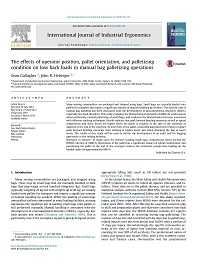Mining Publication: The Effects of Operator Position, Pallet Orientation, and Palletizing Condition on Low Back Loads in Manual Bag Palletizing Operations
Original creation date: May 2015
Many mining commodities are packaged and shipped using bags. Small bags are typically loaded onto pallets for transport and require a significant amount of manual handling by workers. This specific task of manual bag handling has been associated with the development of musculoskeletal disorders (MSDs), especially low back disorders. This study evaluates the biomechanical demands of different work layouts when performing manual palletizing of small bags, and evaluates the biomechanical stresses associated with different stacking techniques. Results indicate that peak forward bending moments as well as spinal compression and shear forces are higher when the pallet is situated at the side of the conveyor as opposed to the end of the conveyor. At low levels of the pallet, controlled bag placement results in higher peak forward bending moments than stacking at higher levels and when dropping the bag to lower levels. The results of this study will be used to inform the development of an audit tool for bagging operations in the mining industry. Relevance to industry: In many cases for workers loading small bags, compression forces exceed the NIOSH criterion of 3400 N. Orientation of the pallet has a significant impact on spinal compression, and positioning the pallet at the end of the conveyor reduces the estimated compressive loading on the lumbar spine by approximately 800 N.
Authors: S Gallagher, J Heberger
Peer Reviewed Journal Article - May 2015
NIOSHTIC2 Number: 20046015
Int J Ind Ergon 2015 May; 47(3):84-92
See Also
- Bag and Belt Cleaner Reduces Employee Dust Exposure
- Biomechanical Modeling of Asymmetric Lifting Tasks in Constrained Lifting Postures
- A Comparison of Fatigue Failure Responses of Old Versus Middle-Aged Lumbar Motion Segments in Simulated Flexed Lifting
- Musculoskeletal Stress on Miners Performing Roof Screening Operations
- Nature and Cost of Low Back Pain
- Physical Strength Assessment in Ergonomics
- Reducing Low Back Pain and Disability in Mining
- Self-Reported Musculoskeletal Symptoms Among Operators of Heavy Construction Equipment
- Strength Testing
- Trunk Extension Strength and Muscle Activity in Standing and Kneeling Postures
- Content source: National Institute for Occupational Safety and Health, Mining Program


 ShareCompartir
ShareCompartir
